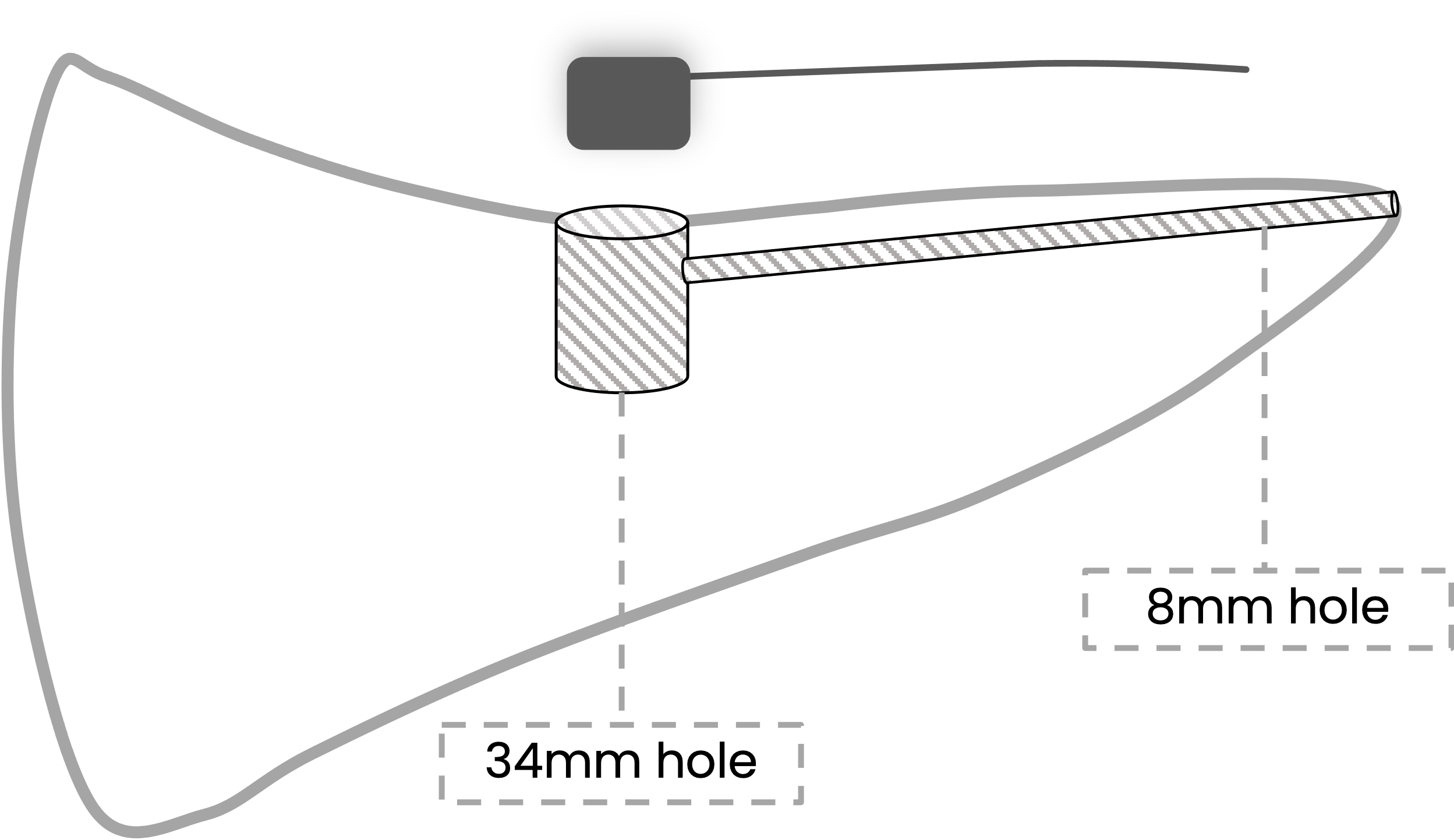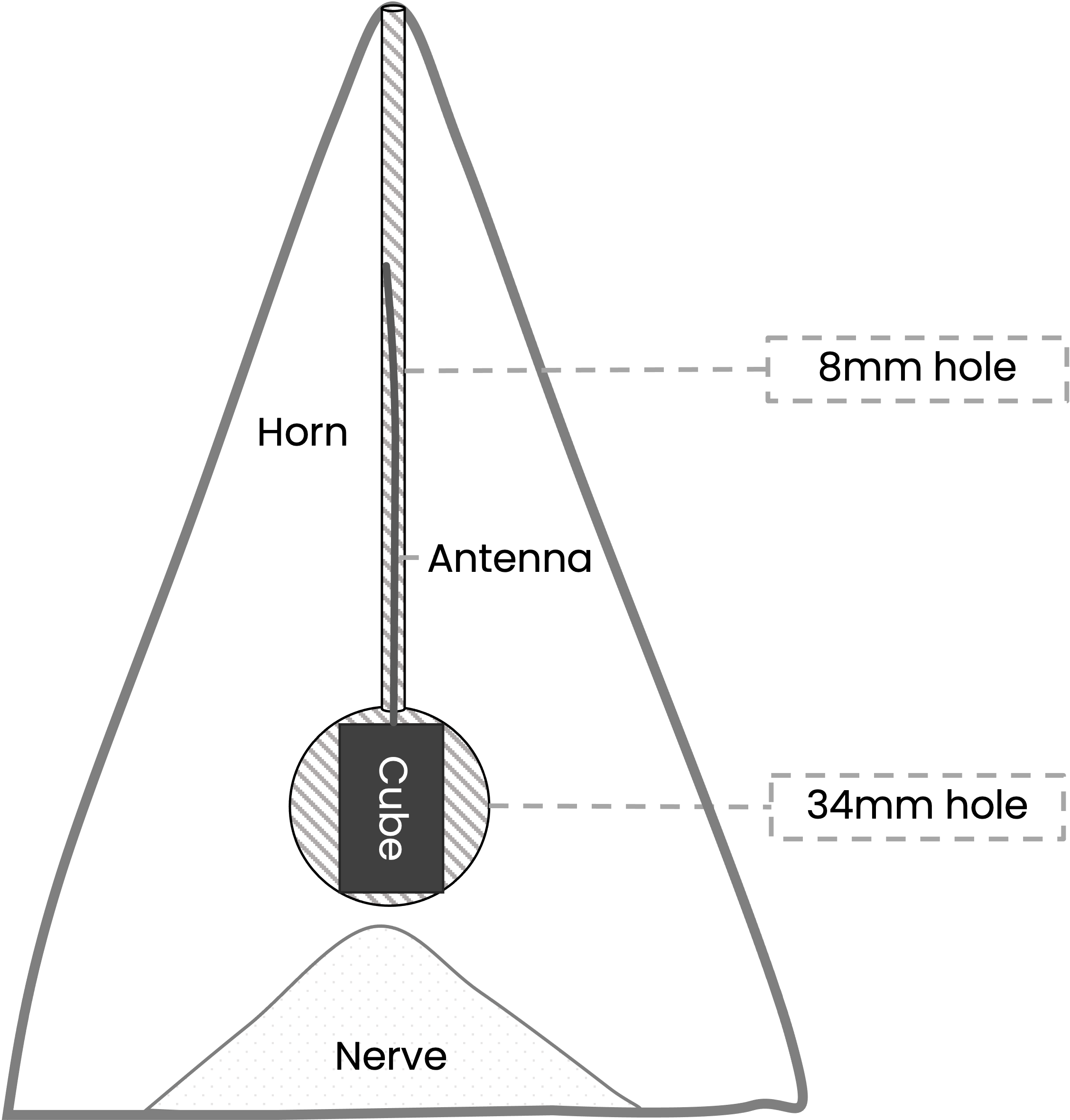¶ RhinoEdge Cube Deployment
Tests with the RhinoEdge tracking devices have shown that rhino horn material blocks the GPS signal significantly. This means even with perfect antenna tuning, getting low power results from any GPS sensor inside a rhino horn is extremely difficult. However, with the adequate tuning and specific placement of each type of RhinoEdge tracker, a stable performance can be accomplished.
We conclude that the less horn material is between the GPS antenna and the satellites in the sky, the better the GPS performance. Therefore, we strongly advice and promote the top-loading method, as this method outperforms the side-loading method. The RhinoEdge Cube and RhinoEdge Puck 34 are designed for the top-loading method. We strongly advice against using the side-loading method with these devices. The RhinoEdge Puck 50 can be deployed using the top-loading and side-loading method, as the antenna surface of this device is significantly larger than the Cube and Puck 34.
For all tracker methods, the exact placement is critical in order to safeguard the performance of the RhinoEdge devices. Therefore, the deployment of the devices should be performed according to the prescribed methods in this document to get a positive result. These methods include the use of specific tools and filament materials.
¶ Specifications
- Dimensions: 24 x 20.5 x 30.5 mm
- Weight: 27 grams
- External LoRaWAN antenna +/- 15,5 cm
- Ceramic GNSS antenna – tuned to this exact deployment method!
- 1 battery – 1200mAh
- High-power GPS: Due to the small battery, the high-power GPS can only be used on a minimum interval of 12 hours. With an average time-to-fix of 30 seconds and a status message interval of 60 minutes, the estimated lifespan of the device is 2 years.
- Low-power GPS: The performance of the low-power GPS is currently unknown, as the LR1110 chip is not performing properly on this device. This is related to the small ceramic GNSS antenna.
¶ Method: top-loading
This device is performing good using the top-loading method, using a Forstner bit 34mm and a Augner bit 8x320mm. The RhinoEdge Cube is inserted into a 34mm hole from the top surface of the inside curve of the horn and a 8mm hole drilled from the tip of the horn is used for the external LoRaWAN antenna. The two holes need to be properly aligned. Placement of this tracker is therefore complicated and requires practice.
¶ Illustrations


¶ Settings
¶ Pre-deployment
¶ Device check
- Ensure the device has the latest device firmware - use the Smart Parks Connect app to check this.
- Ensure the device has the correct settings - use the Smart Parks Connect app to check this.
- If you are using a unique PIN to connect to the device, please make sure you have this with you.
- Ensure the device does not report any critical errors - use the Smart Parks Connect app to check this.
- Ensure the device is JOINED to the LoRaWAN network and is sending messages like expected.
- Check this with scanning the device using the Smart Parks Connect app and look for a JOIN error.
- Check the messages from this device in your LoRaWAN server.
- TIP: do all these checks <24 hours before each deployment, so that you have time to take action if issues occur.
¶ Deployment tools check
- Ensure you have all the needed deployment tools:
- Vettec Adhere 47150
- Vettec mixt tips
- Vettec Applicator
- Forstner bit 34 mm
- Auger bit 8x320 mm
- Android smartphone with the Smart Parks Connect app
- TIP 1: permanent marker
- TIP 2: ruler
- TIP 3: painters tape
¶ Deployment
- Mark the location to drill the 34 mm hole and 8 mm hole
- Drill the 34 mm hole
- Go +/- 35 mm deep → going deeper is possible but will reduce the GNSS signal strength, because the signals have to travel trough more rhino horn material and Vettec Adhere.
- Create a cavity inside the hole → this will ensure the Vettec Adhere can not escape the hole when solidified and creates room to manoeuvre the LoRaWAN antenna into the 8mm hole.
- Drill the 8 mm hole
- Drawing a straight line connecting the 2 holes using a rules and a permanent marker will help to do it first time right.
- Make sure the 8mm hole enters the 34 mm hole +/- 1 cm above the bottom the hole → this is due to the orientation and location of the external LoRaWAN antenna on the device.
- Put the RhinoEdge Cube inside the hole
- Make sure the GNSS antenna (flat surface of the device) is pointing towards the opening the of 34 mm hole → Vettec Adhere is less blocking to GNSS signals then the rhino horn material.
- If you have trouble sliding the external LoRaWAN antenna inside the 8 mm hole, please increase the cavity inside the 34 mm hole using the Forstner bit.
- Apply the Vettec Adhere
- Start with filling up the 8mm hole from the tip of the horn, until you see Vettec Adhere pouring inside the 34 mm hole.
- Now continue with filling up the 34 mm hole by pressing the mix tip all the way to the bottom → pressing and keeping the mix tip to the bottom while pouring in the Vettec Adhere will ensure air bubbels are pushed out.
- NOTE: the Vettec Adhere has a very fast set time of 30 seconds → once you start applying Vettec Adhere you need to commit to ensure there are no air bubbels
- NOTE: the Vettec Adhere will fully cure less then 6 minutes
- Cover the holes with painters tape
- Cover the 34mm hole with painters tape → this will ensure a smooth surface after the Vettec Adhere is solidified
- Check the status of the device by scanning it with the Smart Parks Connect App
- Check the device ID and write it down
- This is probably the last time anyone will be near the rhino allowing it to connect to the device using the Smart Parks Connect app.
- If possible take picture of the deployment for future reference.
- It is very important to continue the reviewing of these deployments, placement of these device have show to be critical for performance.
¶ Post-deployment
- Check the LoRaWAN server for messages coming from the device.
- Are status messages coming in on the expected intervals?
- Are GNSS messages coming in on the expected intervals?
- Check the LoRaWAN messages for critical errors.
- Are there any critical errors reported in the status messages?
- Check the LoRaWAN messages for signal strength.
- Check if the LoRaWAN messages come in with packet-loss → look at the frame counter and see if the LoRaWAN network is missing messages.
- If there is a lot of packet-loss, check what spreading factor the device is using → if needed increase the spreading factor.